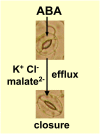Hope for Humpty Dumpty: systems biology of cellular signaling
- PMID: 20032076
- PMCID: PMC2815894
- DOI: 10.1104/pp.109.151266
Hope for Humpty Dumpty: systems biology of cellular signaling
Figures


Similar articles
-
Opening a new era of ABA research.J Plant Res. 2011 Jul;124(4):431-5. doi: 10.1007/s10265-011-0437-7. J Plant Res. 2011. PMID: 21698351 No abstract available.
-
Abscisic acid dynamics, signaling, and functions in plants.J Integr Plant Biol. 2020 Jan;62(1):25-54. doi: 10.1111/jipb.12899. J Integr Plant Biol. 2020. PMID: 31850654 Review.
-
Putting the brakes on: abscisic acid as a central environmental regulator of stomatal development.New Phytol. 2014 Apr;202(2):376-391. doi: 10.1111/nph.12713. Epub 2014 Mar 10. New Phytol. 2014. PMID: 24611444 Review.
-
Xylem and stomata, coordinated through time and space.Plant Cell Environ. 2017 Jun;40(6):872-880. doi: 10.1111/pce.12817. Epub 2016 Sep 30. Plant Cell Environ. 2017. PMID: 27531223 Review.
-
Calcium specificity signaling mechanisms in abscisic acid signal transduction in Arabidopsis guard cells.Elife. 2015 Jul 20;4:e03599. doi: 10.7554/eLife.03599. Elife. 2015. PMID: 26192964 Free PMC article.
Cited by
-
A new discrete dynamic model of ABA-induced stomatal closure predicts key feedback loops.PLoS Biol. 2017 Sep 22;15(9):e2003451. doi: 10.1371/journal.pbio.2003451. eCollection 2017 Sep. PLoS Biol. 2017. Update in: PLoS Biol. 2024 May 1;22(5):e3002592. doi: 10.1371/journal.pbio.3002592. PMID: 28937978 Free PMC article. Updated.
-
Abscisic acid-responsive guard cell metabolomes of Arabidopsis wild-type and gpa1 G-protein mutants.Plant Cell. 2013 Dec;25(12):4789-811. doi: 10.1105/tpc.113.119800. Epub 2013 Dec 24. Plant Cell. 2013. PMID: 24368793 Free PMC article.
References
-
- Agrawal V, Zhang C, Shapiro AD, Dhurjati PS (2004) A dynamic mathematical model to clarify signaling circuitry underlying programmed cell death control in Arabidopsis disease resistance. Biotechnol Prog 20 426–442 - PubMed
-
- Albert I, Albert R (2004) Conserved network motifs allow protein-protein interaction prediction. Bioinformatics 20 3346–3352 - PubMed
-
- Albert R, DasGupta B, Dondi R, Kachalo S, Sontag E, Zelikovsky A, Westbrooks K (2007) A novel method for signal transduction network inference from indirect experimental evidence. J Comput Biol 14 927–949 - PubMed
-
- Albert R, Jeong H, Barabási AL (2000) Error and attack tolerance of complex networks. Nature 406 378–382 - PubMed
Publication types
MeSH terms
Substances
LinkOut - more resources
Full Text Sources

